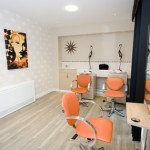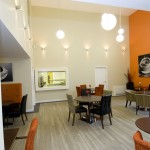
Beneath the well-appointed rooms lies a bistro and a health spa where you can get your hair cut and styled or enjoy a pedicure.
The building, which opened in November, has achieved code level four for sustainable homes. It is heavily insulated, rainwater is harvested for reuse and heating is sourced from photovoltaic and solar thermal technology. A combined heat and power source also produces electricity, with any surplus sold to the national grid. The entire complex is wired for super-fast broadband.
Little wonder Ewart House has just won a ‘best place to live in London’ award in the Royal Town Planning Insitute’s annual London Planning Awards.

A boutique hotel or maybe the latest urban eco-housing?
The only giveaway that Ewart House might in fact be sheltered housing is the fact the ground floor ‘spa’ also offers assisted bathing and the pedicure is really, well, more chiropody. Look more closely and you see the handrails lining the walls and the discrete pacing area for vulnerable residents. The decor and furnishings are also colour coordinated to enable residents with limited vision and dementia to recognise which part of the building they are in; no institutional signage here but subtle ways for residents to get their bearings. In a separate wing with its own entrance are seven flats let to younger people with disabilities and the building is intended to act as a community hub.
Ewart House appears to have substance as well as style; this isn’t just fashionable living for the frail. The extra care sheltered home for frail older people, including people with mild dementia, contains self-contained flats for 47 residents. Almost all flats have a private balcony and some are designed for couples whose fragile health prevents them from sharing a bedroom.The weekly rent and service charges are £135.

The project is a partnership between housing association Harrow Churches (HCHA), which manages the building and provides day time support, and the charity Creative Support, which provides specialist support staff on call 24-hours a day.
With a recent report by the Alzheimers Society suggesting that 50,000 people in the UK are being forced into care homes prematurely, Ewart House has three flats designed for people with mild dementia and the staff are trained in dementia care.
The three-storey building, designed by architects JCMT and styled by interior decorators Stanbridge Interiors, was built using a £6.3m loan from the Homes and Communities Agency, a £3m loan secured by HCHA from Santander and money raised by leasing part of the land to development partner Octavia Housing. Harrow Council pays for employing two teams of staff providing personal care and support while housing support staff are employed by HCHA.
Despite the obvious benefits and official plaudits, HCHA warns the funding climate is a massive threat to creating similar schemes. Chief execuitve Chris Holley says: ‘We’re extremely worried that funding will not be available for more schemes like this despite the substantial social and financial advantages it offers over alternatives like residential and nursing care.
According to one elderly resident, William Fordham, Ewart House is a breath of fresh air: ‘The best thing is the freedom. It’s magic – I have my own flat but carers coming in and out. I didn’t know places like this existed.’ As William’s words suggest, why should losing your youth mean losing your desire for decent décor?
* Images by photographer Lucy Baker

One thought on “Growing old gracefully; shelter with style”
Comments are closed.